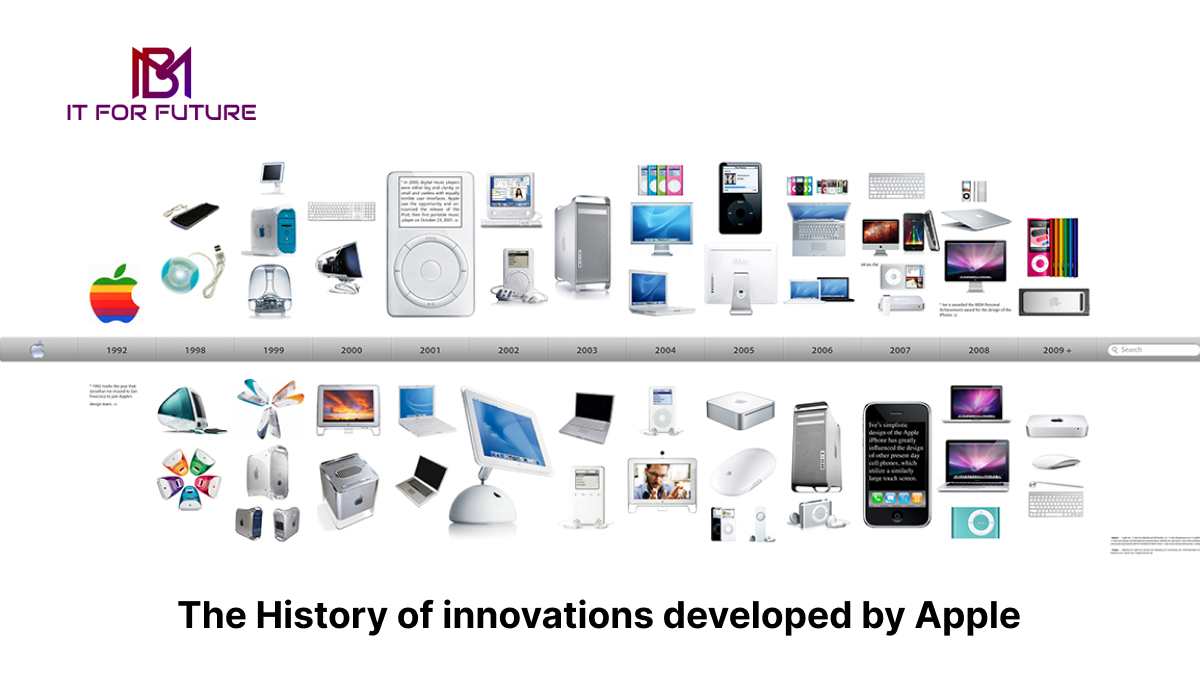In today’s world everybody knows Apple and most of them are using apple products. This is all because of their futuristic innovations. They always try to do something new to attract their customers.
Apple Inc. is more than just a technology company; it’s a cultural icon and a beacon of innovation. From the release of the first Macintosh in 1984 to the latest iPhone models, Apple has consistently redefined industries, set new standards for design and user experience, and maintained a fiercely loyal customer base. In this blog, we’ll explore the history of Apple, its impact on technology and culture, and what the future holds for one of the most influential companies in the world.
1. The Origins of Apple
Apple was founded in 1976 by Steve Jobs, Steve Wozniak, and Ronald Wayne in Cupertino, California. The trio’s goal was to develop and sell personal computers, a concept that was still in its infancy at the time. Their first product, the Apple I, was a simple, hand-built computer that laid the groundwork for the company’s future.
The real breakthrough came with the release of the Apple II in 1977, which became one of the first highly successful mass-produced microcomputers. This success established Apple as a key player in the burgeoning personal computer market and set the stage for its future growth.
2. The Macintosh Revolution
In 1984, Apple released the Macintosh, a revolutionary product that changed the way people interacted with computers. The Macintosh was the first commercially successful computer to feature a graphical user interface (GUI) and a mouse, making it much more accessible to the average user than its text-based predecessors. The iconic “1984” Super Bowl commercial, directed by Ridley Scott, introduced the Macintosh to the world and remains one of the most memorable ads in history.
The Macintosh not only cemented Apple’s reputation for innovation but also set a new standard for user-friendly design, influencing the development of software and hardware across the industry.
3. The Return of Steve Jobs and the Birth of the iMac
After a period of struggle in the 1990s, marked by internal strife and declining market share, Apple made a historic move in 1997 by bringing back Steve Jobs, who had been ousted from the company in 1985. Jobs’ return marked the beginning of a new era for Apple.
One of Jobs’ first major initiatives was the development of the iMac, which was released in 1998. The iMac was a bold departure from traditional computer design, featuring a colorful, all-in-one form factor that became an instant hit. The iMac not only revitalized Apple’s fortunes but also set the tone for the company’s future focus on design and aesthetics.
4. The iPod and iTunes: Revolutionizing Music
In 2001, Apple introduced the iPod, a portable digital music player that would go on to revolutionize the music industry. The iPod’s sleek design, user-friendly interface, and seamless integration with the iTunes software and store made it a must-have device for music lovers.
iTunes, which allowed users to purchase and download individual songs or albums, changed the way people consumed music, paving the way for the digital music revolution. The success of the iPod and iTunes helped Apple establish itself as a major player in the entertainment industry.
5. The iPhone: A Game-Changer
In 2007, Apple introduced the iPhone, a product that would fundamentally change the world. Combining a phone, an iPod, and an internet communicator into one device, the iPhone redefined what a smartphone could be. Its touch interface, App Store, and sleek design set it apart from anything that had come before, and it quickly became the benchmark for the industry.
The iPhone not only propelled Apple to new heights of success but also transformed the way people live, work, and communicate. The App Store, which launched in 2008, created a new ecosystem for developers and led to the creation of millions of apps, further cementing the iPhone’s place in history.
6. The iPad and Beyond
Building on the success of the iPhone, Apple introduced the iPad in 2010, creating an entirely new category of devices. The iPad’s larger screen and powerful capabilities made it ideal for a range of tasks, from media consumption to productivity, and it quickly became a popular tool for both consumers and businesses.
Since then, Apple has continued to innovate across its product lines, introducing new versions of the Mac, iPhone, iPad, and Apple Watch, as well as services like Apple Music, Apple TV+, and Apple Pay. Each of these products and services has contributed to the company’s ecosystem, creating a seamless experience for users across devices.
7. Apple’s Impact on Design and Technology
Apple’s influence extends far beyond its products. The company has consistently set new standards for design, focusing on simplicity, elegance, and usability. Apple’s design philosophy, championed by Steve Jobs and later by Jony Ive, has influenced countless products and industries, from consumer electronics to automotive design.
Apple’s approach to technology has also shaped the industry. The company’s focus on integrating hardware, software, and services has created a cohesive ecosystem that enhances the user experience. Apple’s emphasis on privacy and security has set it apart from competitors, making it a leader in protecting user data.
8. The Future of Apple
As Apple looks to the future, the company is poised to continue its legacy of innovation. Here are some key areas where Apple is likely to focus in the coming years:
- Augmented Reality (AR): Apple has been investing heavily in AR, and the future could see the development of AR glasses or other wearable devices that integrate with the company’s ecosystem.
- Health and Wellness: With the success of the Apple Watch and its health features, Apple is likely to expand its focus on health and wellness, possibly introducing new health-focused products or services.
- Artificial Intelligence (AI): AI will play an increasingly important role in Apple’s products, from Siri enhancements to smarter device interactions.
- Sustainability: Apple is committed to environmental sustainability, and future products will likely incorporate more recycled materials and energy-efficient technologies.
- Electric Vehicles (EVs): Rumors of an Apple car have persisted for years, and while nothing is confirmed, it’s possible that Apple could enter the electric vehicle market in the future, leveraging its expertise in design, user experience, and battery technology.
9. Conclusion
Apple’s journey from a small startup in a garage to one of the world’s most valuable companies is a testament to the power of innovation, design, and vision. Over the years, Apple has not only changed the way we interact with technology but also reshaped entire industries, from personal computing to music and mobile communication.
As we look ahead, there’s no doubt that Apple will continue to push the boundaries of what’s possible, creating products that delight and inspire millions of people around the world. Whether it’s through groundbreaking new devices, innovative services, or a commitment to sustainability, Apple’s impact on the world will continue to be felt for generations to come.


